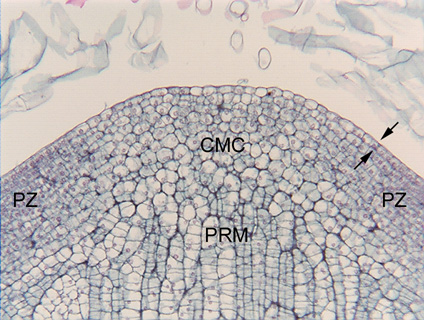 Fig. 6.3-7b.
Magnification of a cactus apical meristem (Oroya depressa). The tunica is
uniseriate (only one layer thick). Along the two peripheral zones, many cell
layers are distinct and orderly, but if you try to follow them through the CMC
zone, they always become irregular, so they cannot be considered tunica layers.
Notice how large the cells of the CMC zone are, and how they do not form rows of
any kind -- these cells appear to divide at random, and as they produce new
cells, they push other CMC zone cells outward, into the peripheral zone or into
the pith-rib meristem. A CMC zone is a promeristem. The bottom of the apex is
dominated by beautifully regular rows of cells (the "ribs" of the
pith-rib meristem); this region is the pith-rib meristem. Obviously, as a cell
is pushed across the boundary between the CMC zone and the pith-rib meristem, it
undergoes a change that causes it to precisely control the orientation of cell
division.
Fig. 6.3-7b.
Magnification of a cactus apical meristem (Oroya depressa). The tunica is
uniseriate (only one layer thick). Along the two peripheral zones, many cell
layers are distinct and orderly, but if you try to follow them through the CMC
zone, they always become irregular, so they cannot be considered tunica layers.
Notice how large the cells of the CMC zone are, and how they do not form rows of
any kind -- these cells appear to divide at random, and as they produce new
cells, they push other CMC zone cells outward, into the peripheral zone or into
the pith-rib meristem. A CMC zone is a promeristem. The bottom of the apex is
dominated by beautifully regular rows of cells (the "ribs" of the
pith-rib meristem); this region is the pith-rib meristem. Obviously, as a cell
is pushed across the boundary between the CMC zone and the pith-rib meristem, it
undergoes a change that causes it to precisely control the orientation of cell
division.